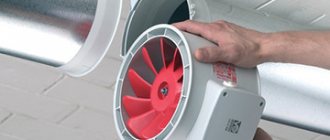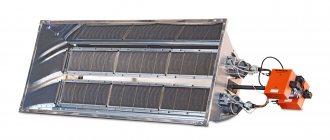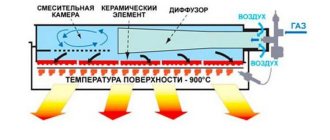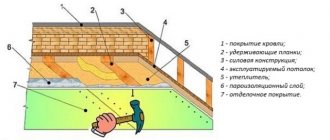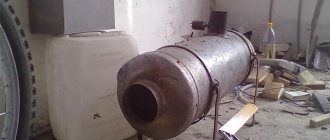Features of infrared heater:
- it warms the place where the radiation is directed, creating comfort comparable to cold nights by the fire, at low air temperatures;
- IR rays can be reflected from mirrored wall panels, so when lining the interior walls of a garage, savings can be made on the number of heaters;
- the costs of such heating are minimal, since the room is heated to the optimal temperature for work very quickly;
- safety and ease of maintenance (compared to other fast heating devices, for example, a potbelly stove).
The heat generated by an infrared heater is distributed better than with a conventional heating method.
The heater begins to function in operating mode 10-30 seconds after switching on, which is much faster than oil radiators. Such devices operate silently. And the operating efficiency breaks all records due to the direct heating of areas in the beam zone.
There are now hundreds of designs of infrared heaters on the market. They can have a different source of radiation: halogen, carbon, quartz lamps and other panels and strips. There are electric and gas infrared heating devices.
In garage conditions, models that are powered by electricity will be optimal. Despite the fact that gas heaters operating on a propane-butane mixture are equipped with a sensor for harmful substances and flame control, they still cannot be called absolutely safe.
Electric infrared heaters also have disadvantages. But they are minor:
- the high cost of some powerful models;
- compliance with installation requirements;
- the opportunity to purchase a low-quality product, a “pirated copy” of a famous brand.
Advantages and disadvantages
IR equipment has its advantages and disadvantages. Positive sides:
- local heating;
- easy connection and installation;
- fast warm-up even at low temperatures;
- variability of placement;
- built-in protection (models with thermostat)
The disadvantages are the price of new models and the high probability of overheating if installed incorrectly.
According to reviews from car owners, IR equipment is best suited for garages and workshops. Heaters are easy to select to suit your needs, and if you have the desire and knowledge, you can make them yourself.
Subscribe to TechnoCouncil on social networks so you don’t miss anything:
Infrared heaters for the garage: types and models
The ceiling in the garage is small, and only long-wave emitters can be used for this room. Models with short and medium waves can only be installed in large warehouses and production facilities (where the ceiling height is from 3 to 8 meters).
Almost all types of long-wave infrared electric heaters can be used in a garage. Popular ones are IR heaters on a stand. According to car enthusiasts, they not only heat the air well in the room, but also help get rid of mold and mildew in damp corners of the garage if the lamps are periodically directed at problem areas of the walls. Garage owners say that the emitter can be used as a dehumidifier for treated surfaces, which is important if there is construction going on in the garage or a workshop is operating. So, if you illuminate the putty with infrared rays, it dries in five minutes, the primer dries in eight minutes, and the varnish takes 12 minutes. The surface becomes smooth and even.
Another feature of the stand-mounted emitter is the ability to heat an outdoor work area with it. So if you change the wheels on your car for winter ones in front of the garage during frosts, such a device will help you not freeze outside.
Infrared emitters on the stand
Stand emitters are usually powered by a quartz or carbon lamp, which is protected by a durable glass tube. Such a lamp is safe; air is removed from the tube space, which eliminates the possibility of fire. According to information from manufacturers, such heaters have a life of 1.5 years of operation in maximum mode without interruption.
The difference for the consumer between a quartz and a carbon lamp is in particular the radiation of the latter, which corresponds to the natural level of human heat.
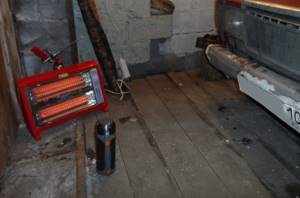
At the same time, a heater with a halogen lamp is not suitable for a garage, since it produces radiation with short waves, unsuitable for rooms with small ceilings.
The infrared film heater can be used in the garage. This type of heating is known as wall panels and infrared underfloor heating. Its advantage over counter-mounted devices is the ability to place the film on the floor, wall, or ceiling. You can connect a control system to the thermostat via a smartphone, and in winter, a warm floor will allow you to avoid wasting time heating the car. You will immediately enter a warm room.
Other features of the film and panel heater:
- does not take up space;
- more economical compared to stand-mounted emitters;
- can be installed in a pit, basement and other areas of the garage that are inconvenient for heating with lamps.

All infrared heaters, whether lamp, panel or film, are safe for the paintwork of the car, environmentally friendly and have a service life of 20 years. If so, then it makes no difference which brand of heater you buy? Not really. It is better to pay attention to European and Russian manufacturers, ignoring companies from the Middle Kingdom.
- Well-known in Russia, “Ballu”, “Master Hit” and “Ecoline”.
- Italian models, “ITM”, are distinguished by good moisture resistance of the case.
- Equipment from Germany from Eckerle, WAGO and Kroll is very economical.
- French heaters produced in Germany have the advantage of small size and high power.
Air heating system for garage
Air heating is not as popular among garage owners as water heating, but with its help you can not only heat, but also ventilate the room.
The method consists of equipping the garage with an air duct with deflectors through which air is supplied, pumped by the fan of a heat gun or fan heater and additionally passed through an air filter.
The main advantage of air heating for a garage is the rapid simultaneous drying of the entire volume, which prevents the aggressive effects of moisture on the car and other furnishings.
Calculation of power of IR heaters
Electric infrared heaters for the garage are selected based on their power. There are many models on the market for rooms of various sizes. The required power is calculated based on the volume of the garage required for heating. It is believed that one cubic meter of garage requires from 25 to 50 W. On average - 35 W per cubic meter.
When purchasing, it is important to already have an idea where the device will be installed. There is a minimum distance standard for a person working in a garage. Thus, the minimum distance to the head should be no more than 0.7 meters (with a heater power of about 750 W). If the device is more powerful, then the distance increases in direct proportion.
Online stores have offers for portable heaters with low power, such as 300 W. They are well suited for the garage, as they quickly heat the air to a comfortable temperature in a certain area and do not waste much electricity. You can work comfortably next to them even on the street.
The plates can heat up to a temperature of 600°. But the body is almost never above 60°. The weight of the devices does not exceed 5 kg, they can be carried with one hand.
Hygiene and injury safety
The location of the IR heater should prevent accidental contact with the emitting plate. Its temperature in low-power devices is about 80 °C.
Handprints on the emitting plate become clearly visible over time. Cotton gloves will protect you from touching the emitter with your palms when installing the infrared heater.
The first switching on of the device may be accompanied by the smell of technological lubricant. It will evaporate within a few hours of operation at maximum power. All that remains is to ventilate the garage.
DIY IR heater
If you want to do something yourself, you can make your own IR heater. There are many ways described on the Internet, from the real to the most incredible. We studied them and selected the two most realistic options for creating an infrared heater for the garage.
The easiest way is to make a heating device from an old reflector with a spiral, which can be purchased at a flea market, according to advertisements on the Internet. In addition to the Soviet-style reflector, you will need:
- steel rod;
- fireproof dielectric (a plate made of glazed ceramics is suitable);
- nichrome thread.
Having all these parts, making a heater is quite simple.
- First, check the integrity of the electrical cable, the plug of the Soviet reflector. If there is dust on the reflector of such a device, it must be removed.
- Take out the spiral and measure its length. Take a steel rod of the same size as the spiral and wind a nichrome thread onto the rod in 2 mm increments. Remove the resulting spiral.
- Take a fireproof dielectric (plate) and place your spiral on it. Connect it to the current so that the turns do not touch. Wait until it warms up. Disconnect from current.
- Take the spiral and place it in the groove of the reflector cone, connecting it to the power supply.

The second option is to make a heater from glass and foil. This option is more suitable for those who are fans of the “Crazy Hands” program, since the heater is made from a bunch of unnecessary things.
A convincing guideline is prices
The price of a heater of any type depends on its power, functionality and manufacturer.
To compare different heaters, we will take as mandatory parameters a maximum power of 2.8 kW, the presence of a rheostat for power adjustment and basic safety features that are relevant for using the device in a garage. For electric models, a voltage of 220 Volts is a prerequisite.
Oil heater Termica Comfort 1120 (China). Three levels of power adjustment (2900 W, 1500 W and 1000 W). Overheat and tip-over shut-off function, frost protection. There is a small fan available. Price 3,300 rub.
Electric convector AEG WKL 3003S (China). Maximum power 3 kW. The presence of a thermostat, protection against overheating and capsizing. Floor or wall installation. Price 5,700 rub.
Gas convector Bartolini Calorama FB 4000 (Italy). Maximum power 4 kW. Closed combustion chamber, electric ignition from batteries. Price 12,900 rub.
Electric fan heater Comfort TPK-3000 (Russia). Two levels of power adjustment (3000 W and 1500 W). Ceramic heater, overheat protection. Price 3,700 rubles.
Gas gun Ballu BHG-10 M (China). Maximum heating power 10 kW, power adjustment using a gearbox. Fan power consumption 32 W. Price 4,900 rubles.
Indirect action diesel gun. Maximum heating power 25 kW, fan power consumption 290 W. Thermostat with automatic shutdown support. Price 28,500 rubles.
Infrared heater NeoClima Shaft-3.0 (Greece). Two levels of power adjustment (3000 W and 1500 W). Quartz heating element, thermostat. Wall and floor installation. Price 3,600 rubles.

Before going to the store, you need to carefully study the issue of heating your garage, otherwise there is a high probability of an unsuitable purchase
Stages of work:
- We smoke glass. To do this, a lit candle must be placed on the table, and the plates must be moved alternately over its flame. It is necessary to have a layer of soot on only one side of each piece of glass.
- We clean the edges of the glass from soot with cotton swabs so that we get a transparent frame 5 mm wide.
- Take a piece of aluminum foil and cut out a couple of rectangles the width of a soot rectangle and a little longer than a piece of glass. In our case, the soot will be a conductor, and the pieces of foil will be electrodes.
- Let's assemble our device. To do this, turn the glass plate with the soot side, apply epoxy glue to it, and place two pieces of foil so that both ends extend beyond the glass. We attach the second plate on top so that the layer of soot is inside. Let the glue work.
- We treat our device with sealant.
- We take a multimeter and replace the resistance or power of the heater. If you can only determine the resistance, then to calculate the power you need to multiply the resistance by the squared current.
- Typically, the power does not exceed the value allowed by regulations. But if it doesn’t work out, and it’s higher, you’ll have to rebuild the heater again. Remember that the wider the soot strip, the less resistance.
Assembling heaters from scrap parts is good fun for Sunday garage get-togethers. But if you plan to use the device often, care about safety and are not very limited on funds, then buy a factory-made heater. After all, such infrared devices are more reliable than even a reflex radiator with an open spiral. Its use is dangerous in a garage, since the combination of a hot element and gasoline and oil vapors can create the risk of a fire.
In modern models, all hot parts (if any) are hidden firmly in glass, so you can use them in the garage with the car engine running and not fear for your life.
The use of infrared heaters in various rooms (including the garage) is described in this video.
Heater for the garage: the most frequently asked questions
The most popular garage heaters are fan heaters and infrared heaters. Both types can operate either on electricity or on propane (less commonly natural gas). Electric ones are usually more expensive to operate, but they are popularly considered safer, while propane ones are cheaper, but require stricter compliance with safety rules and the constant availability of gas cylinders.
Fan heaters drive large volumes of air through heating elements - and the hot air quickly fills the entire air space of the room.
Infrared devices use the principle of soft radiant heating; they heat not the air, but the walls, floor, ceiling and objects in the room, which then release heat to the air. Therefore, it is recommended to place such devices not too high and far from you, otherwise you may not feel the heat.
When choosing a heater, the most important thing is the area of the room. It is irrational to use a heater that is too powerful for a small garage or to try to heat a large workshop with a small portable heater. In small rooms, it is enough to install infrared heaters: their power is less than that of a fan heater, but it is enough to heat such a space. In addition, they begin to heat up faster.
For a large garage, it is wise to acquire a powerful fan heater that can maintain an optimal microclimate for a long time even in the iciest room.
Thermal output of heaters is measured in BTU/hour (propane models) and Watts (electric models). The higher these indicators, the more area the device can heat. Having decided to purchase an electric heater, calculate how many watts you will need to heat the room: to do this, multiply its area by 8 and round. We emphasize: this is an approximate result, since a lot depends on the climate zone, ceiling height, etc.
For a small garage, a heater with a power of 1000-1500 W is enough (5000 BTU/h for propane models), and medium-sized garages need a heating power of 2500 W. Large garages and workshops require much more heat - so aim for devices marked “commercial” from 5000 W (or from 17000-18000 BTU/h and more).
In this Guide, we have collected the 5 best models of propane and electric garage heaters that the modern market offers for rooms of different sizes. There is no longer any need to guess what is the best way to heat your garage: all you need is to know its area and choose the preferred fuel to operate the device. In our review you will find 3 electric and 2 propane heaters.

